The National Register of Historic Places (NRHP) is the United States federal government's official list of districts, sites, buildings, structures and objects deemed worthy of preservation for their historical significance or "great artistic value". A property listed in the National Register, or located within a National Register Historic District, may qualify for tax incentives derived from the total value of expenses incurred in preserving the property.

Alcatraz Island is a small island in San Francisco Bay, 1.25 miles (2.01 km) offshore from San Francisco, California, United States. The island was developed in the mid-19th century with facilities for a lighthouse, a military fortification, and a military prison. In 1934, the island was converted into a federal prison, Alcatraz Federal Penitentiary. The strong currents around the island and cold water temperatures made escape nearly impossible, and the prison became one of the most notorious in American history. The prison closed in 1963, and the island is now a major tourist attraction.
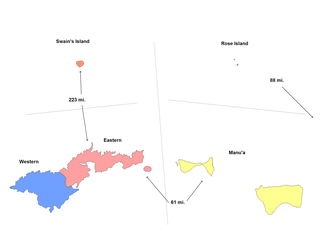
This is a list of the buildings, sites, districts, and objects listed on the National Register of Historic Places in American Samoa. There are currently 31 listed sites spread across the three districts of American Samoa. There are no sites listed on the unorganized atoll of Swains Island.

This list is intended to be a complete compilation of properties and districts listed on the National Register of Historic Places in Rensselaer County, New York, United States. Seven of the properties are further designated National Historic Landmarks.
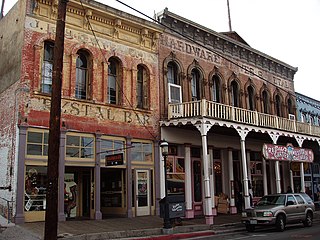
Virginia City Historic District is a National Historic Landmark District encompassing the former mining villages of Virginia City and Gold Hill, both in Storey County, as well as Dayton and Silver City, both to the south in adjacent Lyon County, Nevada, United States. Declared a National Historic Landmark in 1961, the district is one of only six in the state of Nevada.
New Russia was a trading-post for furs and a penal colony established by Russians in 1796 in present-day Yakutat Borough, Alaska. It was presumably named after the Joseph Billings ship Slava Rossii, or "Glory of Russia".

This is a list of the National Register of Historic Places listings in Washita County, Oklahoma.
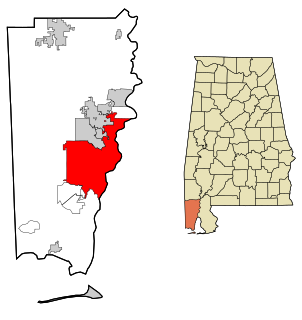
This is a list of the National Register of Historic Places listings in Mobile, Alabama.

The Field Matron's Cottage, also known as the Stone Building, was built circa 1925 on the Reno-Sparks Indian Colony in Sparks, Nevada. The cottage was built to support a Bureau of Indian Affairs program to instruct the 20 acres (8.1 ha) colony's Paiute and Washoe girls in sanitation and housekeeping skills. A "field matron" was provided by the Bureau from 1919 to as late as 1938. At first the matron lived in Reno, at some distance from the colony, but in 1926 funding was made available to build a dwelling on colony lands, allowing a closer relationship between the matron and the colony's inhabitants. The cottage included a library and an infirmary, and served as a community meeting place.

St. John's Church is a historic church at 101 Chapel Street in Portsmouth, New Hampshire, United States. The brick building was designed by Alexander Parris and built in 1807; it was the first brick church in the state of New Hampshire, and is a rare surviving early design by Parris. The building was listed on the National Register of Historic Places in 1978. The church is home to an Episcopal congregation organized in 1732, with roots in the city's 17th-century founding.

Anderson Street is a New Jersey Transit rail station on the Pascack Valley Line. The station is one of two rail stations in Hackensack and located at Anderson Street near Linden Street.

Shoshone-Episcopal Mission is a historic mission and school in Fort Washakie, Wyoming. The school was built from 1889 to 1890 by Rev. John Roberts, the minister and teacher on the Wind River Indian Reservation. Roberts built the boarding school to teach the Shoshone girls living on the reservation; as many of the students lived up to 20 miles (32 km) away from the school, it was necessary to build a boarding school to teach them. The school later became the headquarters of the entire Episcopal mission on the reservation.

George L. Brooks School is a historic former school building located in the Haddington neighborhood of Philadelphia, Pennsylvania. It was designed by Henry deCourcy Richards and built in 1919, encompassing part of the original walls of the 1902 edifice that had been destroyed by fire. It is a three-story, five bay, stone and brick building on a raised basement in the Late Gothic Revival-style. It features a slightly projecting entrance bay with Gothic arched entryway and a crenellated parapet.

Colony's Block is a historic commercial building at 4-7 Central Square in the heart of Keene, New Hampshire. The five-story brick building was built in 1870 to a design by Worcester, Massachusetts, architects E. Boyden & Son, and is the city's most prominent example of Second Empire architecture. In addition to being a long-standing commercial center, the building housed the city library from 1870 to 1877. The building was listed on the National Register of Historic Places in 1983.

The Townsend Farm is a historic farmstead on East Harrisville Road in Dublin, New Hampshire. Built about 1780 and enlarged about 1850 and again at the turn of the 20th century, it is one of Dublin's older houses, notable as the home and studio of artist George DeForest Brush, one of the leading figures of Dublin's early 20th-century art colony. The house was listed on the National Register of Historic Places in 1983.

The Brick Schoolhouse is a historic one-room schoolhouse at 432 New Hampshire Route 123 in Sharon, New Hampshire. Built in 1832, it is the only of the town's three such buildings to survive, and was the only one made of brick. It is also the only school building now standing in the town, since its students have been schooled in neighboring Peterborough since 1920. The building was listed on the National Register of Historic Places in 2002, and the New Hampshire State Register of Historic Places in 2001.
John Homer Seger was an American educator best known for his work with the Arapaho tribe in Oklahoma.
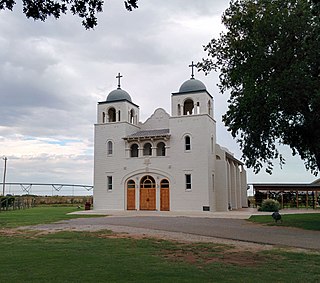
The Darlington Agency was an Indian agency on the Cheyenne and Arapaho Indian Reservation prior to statehood in present-day Canadian County, Oklahoma. The agency was established in 1870. The agency established at Fort Supply the previous year was moved to a more accessible location for the tribes. Brinton Darlington, a Quaker for whom the agency was named, was the first United States Indian agent at the agency, a position he held until his death in 1872.
The D.H. Anderson Building, also known as the Sue's Hallmark Store, was a historic building located in Maquoketa, Iowa, United States. The three-story brick building was built in 1882 by Dr. Galloway Truax, a local druggist. The grocery firm of D. H. Anderson initially occupied the first-floor commercial space, and Anderson bought the building in 1888. It remained in the family until 1956. A lawyer and the Knights of Pythias occupied the second floor, and the Masons occupied the third floor. The building had an unusual gable roof to accommodate the Masons' desire for a vaulted ceiling. After the Masons moved out in 1902, the Knights of Pythias occupied the third floor until 1957. Various retail establishments occupied the first-floor retail space. The building was damaged in a 1971 fire. It was listed on the National Register of Historic Places in 1986.
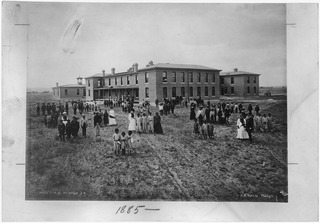
Albuquerque Indian School (AIS) was a Native American boarding school in Albuquerque, New Mexico, which operated from 1881 to 1981. It was one of the oldest and largest off-reservation boarding schools in the United States. For most of its history it was run by the Bureau of Indian Affairs (BIA). Like other government boarding schools, AIS was modeled after the Carlisle Indian Industrial School, using strict military-style discipline to strip students of their native identity and assimilate them into white American culture. The curriculum focused on literacy and vocational skills, with field work components on farms or railroads for boys and as domestic help for girls. In the 1930s, as the philosophy around Indian education changed, the school shifted away from the military approach and offered more training in traditional crafts like pottery, weaving, and silversmithing.

















